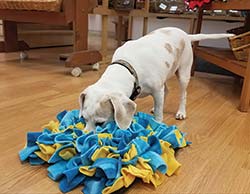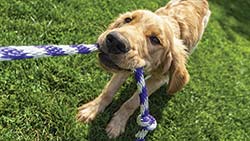My elderly dog recently went spontaneously blind and her usual entertainment and exercise was not longer possible. So I started to do some research, and found that dogs need physical exercise, yes, but equally important is providing exercise for your dog’s mind. Bored dogs may become destructive, and anxious. They can chew up furniture or bark excessively, among other behavioral manifestations. But dogs left without any challenges to their mind can also become depressed, sleeping excessively or engaging in repetitive behaviors.
Taking steps to stimulate your dog’s brain is important at all life stages. As puppies, brain games build confidence, while adult dogs need mental challenges to stay engaged and problem solve. Older dogs may benefit from less cognitive decline, as it’s estimated that one-third of dogs may start to lose some brain function by the age of 8.
Even dogs recovering from surgery or left home alone for a few hours can benefit from mental engagement to keep boredom at bay. An added bonus of engaging your dog in learning games is that it strengthens the bond you share. Here are some of the best solutions I’ve found for dogs needing something a little more than fetch or chewing treats.
7 Mentally Stimulating Games for Dogs
Ready to challenge your dog with a fun dose of mental stimulation to get their brain working? Here are seven options to try out. Ideally, ensure your dog has basic obedience and knows how to respond to verbal commands like sit, stay and lie down before trying out these games, as they’ll be a lot more fun this way. Plus, obedience training is a form of mental stimulation, too.
• Play hide and seek — This game speaks to your dog’s desire for scent tracking. To play this classic game with your dog, you’ll do the hiding — your pup will do the seeking. Start out with some easy hiding spots and stash a few treats there. Tell your dog to “sit and stay,” then go hide.
After a few moments, yell for your dog to “come” — and try to stay quiet while they find you, offering a few clues if necessary. When your dog finds you, reward him with a treat and praise. Gradually move to more challenging hiding places and continue to reward your pup with lots of praise when he finds you.
• Problem-solving games — Many dogs love to problem-solve and get a confidence boost when they do so. One simple game involves only a shoelace and a treat. Tie the treat to the shoelace and, with your dog watching, place it under an obstacle that your dog can’t fit under. Leave one end of the string out, accessible to your pup, but place the treat far enough under so your dog can’t reach it.
Let your dog try to figure out how to pull the string to get to the treat. After a few minutes, you can demonstrate how it’s done, then give your dog another try. Most will catch on quickly. If you need something easier or ready made consider a snuffle mat or snuffle toy that is designed to hold treats and be easy to find but enough of a challenge they need to use their problem solving skills.
• Tug-of-War — Grab a tug toy and gear up for a game that’s both physically and mentally challenging for dogs. If your dog gets overly rowdy or aggressive, stop the game, but otherwise, let your dog do most of the work pulling the toy toward him — and be sure to let him win sometimes.
Playing tug can boost your dog’s confidence and help him learn to work as a team, while also using self-control. You can also practice obedience skills, including “drop it,” while playing this brain game.
• Create a digging box — A fun option for dogs that love to dig is to create a digging box that you place in your yard. Fill it with sand and bury toys for your dog to discover.
• K9 nose work — Most pet dogs don’t get to use their noses for the purposes they were designed for. K9 nose work, also referred to as scent work, provides your dog with a mental and physical outlet to burn energy and enjoy being a dog. This is exceptionally helpful for reactive dogs that can’t be around other dogs, or older dogs that prefer not to leave their immediate surroundings, but still need daily enrichment.
For more information, you can visit K9 Nose Work or the NACSW (National Association of Canine Scent Work). While you can sign up for classes to work with your dog on nose work, once you learn the techniques you can work with your dog on your own playing K9 nose work games at home.
• Put toys away — Many dogs enjoy engaging in purposeful “work.” One job you can teach your pup is how to pick up a toy, walk with it to the toy basket, drop it in and leave it. Start out slowly, by handing your dog a toy while you’re both near the basket, then telling him to “drop it” in the bin. Reward your dog with a treat and praise. Repeat the process with another toy, and as your dog learns the process, try it with toys farther away from the basket.
Once your dog is reliably returning individual toys to the basket, you can begin rewarding him only after he returns two toys, then three, and so on. Eventually, he gets rewarded only after every toy is back in the basket.
• The ‘destroy it’ game — Does your dog love to tear apart stuffies or unroll an entire toilet paper roll? This is a brain game for him. Fill a cardboard box with old, scrunched up newspapers, empty paper towel rolls and other “stuffings.” Close it up and let your dog go to town, unstuffing the box and destroying it.
Be careful that your pup isn’t eating any of the fillings or cardboard. If he’s not, you can also add more interest by placing a few treats in the box for him to discover while he destroys it. |
Beyond games, there are many other ways to keep your dog mentally challenged on a daily basis, including taking him to explore outdoors and visit new places as much as possible. Also, spend time with your pup, playing, snuggling and exercising together. The more you include your dog as part of your “pack,” the more he’ll stay mentally stimulated and engaged.
|